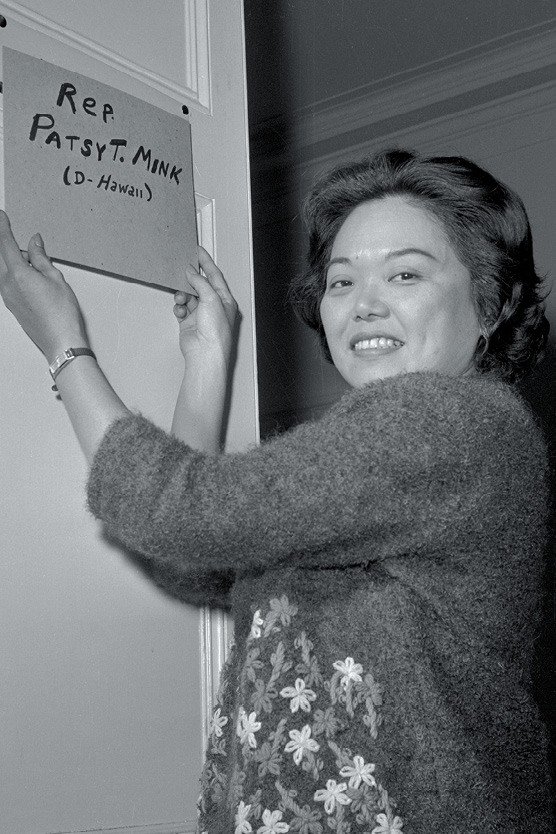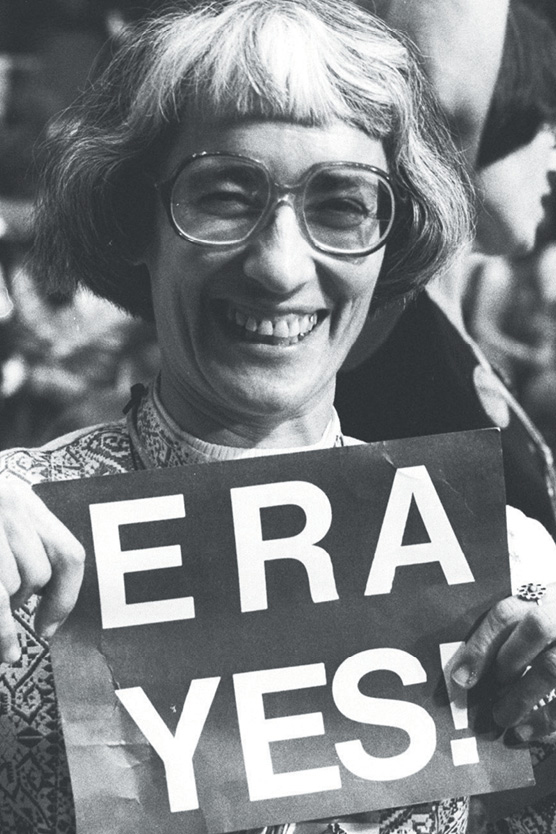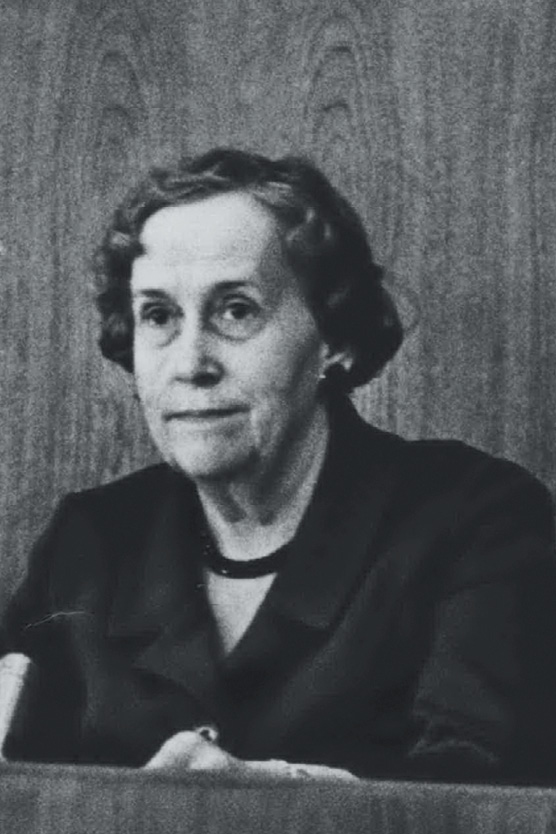Patsy Mink, Bernice Sandler, and Edith Green

PATSY MINK

BERNICE SANDLER

EDITH GREEN
Hillary
Believe it or not, when I was in high school, I played basketball. We didn’t have an interscholastic league, but it was a big school—about five thousand students—so there was a lot of competition. But in those days, girls’ basketball meant half-court basketball. We either played offense or defense, and could run only as far as the center line before we had to stop and go back in the other direction. The prevailing wisdom was that running back and forth the full length would be dangerous for girls’ health and well-being.
Today girls not only play on the full court but have more opportunities than ever to excel in sports and in school. None of this would have been possible without Title IX. And Title IX wouldn’t have been possible without three women who had one door after another closed in their faces, only to kick them wide open.
“No person in the United States shall, on the basis of sex, be excluded from participation in, be denied the benefits of, or be subjected to discrimination under any education program or activity receiving Federal financial assistance.”
—TITLE IX OF THE EDUCATION AMENDMENTS ACT OF 1972
Patsy Mink was born in 1927 on the island of Maui, the granddaughter of Japanese immigrants who came to Hawaii to work the sugar plantations. Her father revered Franklin Delano Roosevelt, and Patsy used to sit under the mango trees in the backyard, listening to the president’s fireside chats on the radio. She played basketball for Maui High School, though she was, of course, never allowed to play full court.
After the Japanese attack on Pearl Harbor in 1941, local authorities began arresting prominent Japanese Americans and holding them for questioning. Patsy’s father, a civil engineer, was taken away in the night. Though he returned home the next day, it cast a shadow over their family. More than one hundred thousand Japanese Americans would ultimately be forced into internment camps between 1942 and 1945. Patsy never forgot the sight of her father burning his Japanese mementos. “It made me realize that one could not take citizenship and the promise of the U.S. Constitution for granted,” she later said.
As a high school senior, she became her school’s first female student body president—the prelude to what would be a lifetime of firsts. After finishing high school as valedictorian, Patsy graduated from the University of Hawaii in 1948, then decided to apply to medical school. She received more than a dozen rejections, despite knowing she was just as qualified as any male candidate. “It was the most devastating disappointment in my life,” she later recounted. She then decided to apply to law school, and was one of two women accepted to the University of Chicago. She later found out she had been accepted by mistake, designated as an “international student” despite the fact that Hawaii was a territory of the United States. After graduation, she returned home to learn that government officials would permit only Hawaii residents to take the bar exam required to practice law there. Though Patsy had been born and raised in Hawaii, her husband had not; her marriage perversely made her a nonresident. She fought for her right to take the exam and won.
Interviewing for jobs presented yet another hurdle. Patsy was turned away from one firm after another and advised to stay home with her young daughter. Frustrated, she decided to start her own practice. For her first case, she accepted a fish as payment. She never intended to run for office, but the indignity of being denied a job simply because she was a mother changed her outlook. She won her first race for a Hawaiian territorial House seat by going door-to-door and talking to voters—something we might call “the old-fashioned way” today, though it was far from a common tactic at a time when many politicians were simply born and raised into political families. She eventually ran for the United States Congress and won in 1964, becoming one of thirteen women serving at the time.
“Women have a tremendous responsibility to help shape the future of America, to help decide policies that will affect the course of our history.”
—REPRESENTATIVE PATSY MINK
When she arrived in Washington, Congresswoman Mink endured a barrage of sexist and racist stereotypes that still sound all too familiar today. Newspapers described her as “diminutive” and “exotic” and accused her of neglecting her child in order to pursue a career. She dealt with it head-on. When a reporter asked her how she balanced being a wife and a congresswoman, she calmly responded: “I think that’s the most offensive question that’s ever asked. I’ve never heard anyone ask a man, ‘How has it been on your family?’ ”
In Congress, she saw herself as representing not only the people of Hawaii but also the women of America. Along with her small but mighty group of fellow congresswomen, she protested being barred from the all-male congressional gym. (Patsy later explained that what she really wanted was use of the swimming pool, where male members of Congress liked to swim nude. “Is it too much for the democratic process to ask you to put your pants on?” she asked.) She introduced the first federal child care bill, as well as legislation to support bilingual education, student loans, special education, and Head Start. She was an outspoken proponent of women’s rights, civil rights, and the environment, and opposed the Vietnam War.
She knew from personal experience that what is right is not always popular. She lost her fair share of elections—for U.S. Senate, for governor of Hawaii, for mayor of Honolulu, even for president of the United States. Determined to serve, she sat on the Honolulu City Council, then ran for governor and mayor before winning back her congressional seat in 1990. Driving everything she did was the belief that government can and must make people’s lives better. But of all her many accomplishments, the one she is perhaps best known for is being one of the principal authors of Title IX.
Like Patsy Mink, Bernice “Bunny” Sandler, who was born a year later in Brooklyn, New York, grew up hearing a chorus of voices telling her what girls should and shouldn’t do. As she has said, she’d become so accustomed to it that she never would have called it upsetting or unfair—until the time came to apply for a job. Bernice had been teaching part-time at the University of Maryland while finishing her doctoral work in education. Yet she was informed that once she finished, she wouldn’t be considered for any of the half dozen permanent positions in the department. Confused, she asked a faculty member why not. His answer stayed with her for the rest of her life: “Let’s face it,” he said. “You come on too strong for a woman.”
His comment was laughable in its bluntness, but Bunny wasn’t laughing. “I went home and cried,” she said. At home, she recalled every time she had spoken out in class or in a department meeting. Over the next few months, she experienced a string of similar rejections: The research executive who spent nearly an hour explaining that he never hired women because when their children got sick, they wouldn’t be able to come in to work. The counselor at an employment agency who glanced at her résumé and informed her that she was “not really a professional” but “just a housewife who went back to school.”
It wasn’t until her husband said the words that she realized what was happening to her had a name: sex discrimination. She started doing her research. One day, reading a report on the impact of anti-discrimination laws on racial discrimination, she came across an executive order from President Johnson prohibiting any federal contractor from discriminating on the basis of race, color, religion, or national origin. Then she noticed the footnote: It said that the executive order had been amended to ban discrimination based on sex.
“Even though I was alone, I shrieked aloud with my discovery,” she said. “I had made the connection that since most universities and colleges had federal contracts, they were forbidden from discriminating on the basis of sex.” So began a national campaign. In 1970, she filed a class action complaint against all universities and colleges in America, on behalf of all women in higher education. She pulled together eighty pages of background material. At the time, many colleges held women to a tougher admissions standard, or imposed a quota on how many they would accept—like the Cornell School of Veterinary Medicine, which admitted two women a year, regardless of the number of applicants. Some barred women altogether. Female students had a curfew, while male students could stay out as late as they wanted. At the time, all of this was completely legal.
“A woman has to work twice as hard as a man to prove that she can do the job.”
—REPRESENTATIVE EDITH GREEN
At Bunny’s urging, Representative Edith Green from Oregon held the first congressional hearings on the education and employment of women. As a young woman interested in science, Edith had been discouraged from pursuing a career as an electrical engineer because of her gender. Financial hardship led her to drop out of college (she would eventually return and graduate), so she was dedicated to making education affordable and accessible for all. Her background and passion for education, particularly as a former educator herself, led Edith’s colleagues to affectionately refer to her as “Mrs. Education” and the “Mother of Higher Education.” In her remarks opening the hearings, she got right to the point. “Let us not deceive ourselves,” she said sharply. “Our educational institutions have proven to be no bastions of democracy.”
For the next seven days, women members of Congress testified about the discrimination they had experienced. With the help of Representatives Mink and Green, Title IX was drafted, passed, and signed into law in 1972 by President Nixon, requiring equal opportunities for boys and girls in education. It would take nearly five more years before the law was enforced. In the process, they had to take on university administrators and their fellow congressmen who claimed the bill would force schools to build unisex locker rooms and admit equal numbers of male and female students. After the bill passed, Representative Green mused, “I don’t know when I have ever been so pleased, because I had worked so long and it had been such a tough battle.”
Nearly fifty years later, Title IX has transformed educational opportunities for generations of women and girls. In 1972, women comprised 9 percent of law school students; today they’re more than half. Since the passage of Title IX, girls’ participation in high school sports has increased by more than 900 percent. Before Title IX, there were only 700 girls participating in high school soccer programs in the United States; now there are more than 390,000. Anyone who loved cheering the U.S. women’s national soccer team on to their fourth World Cup win has Title IX to thank. And Title IX has shaped the sport worldwide: The UK, Chile, Jamaica, New Zealand, Nigeria, Scotland, Spain, Thailand, and Canada all had players on their 2019 Women’s World Cup teams who trained in the United States. Though the fight for fair treatment continues: Players on the U.S. women’s team will earn about $250,000 each in prize money for winning the World Cup, while players on the men’s team would have been paid $1.1 million. The message was unmistakable when, after the final match, the stadium erupted with the best chant of the game: “Equal pay! Equal pay!”
CHELSEA
We’ve definitely come a long way since your half-court basketball days, Mom! After the hundredth (or more) time my friend Elizabeth and I had played basketball in her driveway as kids, and I had lost yet again, I finally accepted that I had no talent for the game. But that didn’t diminish my later enthusiasm for the remarkable women of the Women’s National Basketball Association (WNBA). In April 1996, during my junior year in high school, the NBA announced that it was launching a women’s league, the WNBA, the following year. Players Lisa Leslie, Rebecca Lobo, and Sheryl Swoopes were all at the press conference. These three phenomenally talented women had won multiple awards in their college careers and would go on to be Olympic teammates that summer at the Atlanta Olympic Games. Less than a month into the new WNBA’s inaugural season, Lobo became the first player to win one hundred consecutive games. Her streak would stretch to 102. I’ve always loved that Rebecca approached sportswriter Steve Rushin to ask him why he had mocked women’s basketball in the pages of Sports Illustrated. (He “joked” that he’d snored through a WNBA game and thus had slept with 7,138 women in a single night.) Rebecca corrected him, pointing out that they got 15,000 fans at Madison Square Garden, and he admitted he’d never actually been to a game. She invited him to see the Liberty play; he accepted, and less than two years later, they got married.
Our work is far from finished. Women’s sports still receive only a sliver of media coverage. The gains in participation still leave too many girls behind, especially young women of color, girls from immigrant families, girls with disabilities, and students from low-income families. And too many women athletes, even when they do have the opportunity to compete, are often paid much less or subjected to a damaging double standard when it comes to behavior. This is especially true of women of color—just ask Serena Williams. But the story of Title IX and the triumph of its “godmothers” remind us that strength in women is an asset to be cultivated, not a character flaw to be overcome.